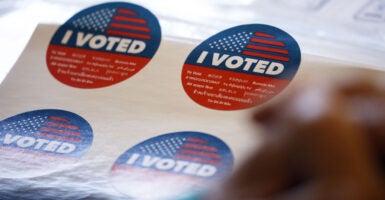Voters in Western states and the District of Columbia voted on some form of ranked choice voting or “jungle primaries” that includes ranking the final candidates in the general election.
Voters in Nevada, a battleground state in the presidential race, rejected Question 3, according to Ballotpedia. This was a ballot measure that would have moved the state to a “top five” primary if approved. That means up to five at-large primary candidates would compete in a ranked choice voting general election.
In another battleground, Arizona voters rejected Proposition 140, which would have established primaries in which candidates would appear on a single ballot, regardless of party affiliation, according to Ballotpedia. The top finishers would go on to the general election. The measure also would require one candidate to win a majority of the vote in the general election. If three or more candidates advance to a general election, it would require ranked choice voting.
District of Columbia voters approved Initiative 83 to allow unaffiliated voters to vote in a party primary. It also would establish ranked choice voting for general elections beginning in 2026.
South Dakota voters rejected a measure to replace party primaries with a ranked choice voting system, Ballotpedia reported.
Voters in Missouri and Colorado also appeared poised to say no to ranked choice voting proposal, while another measure in Colorado appeared to be lagging, according to Ballotpedia.
Meanwhile, Alaska voters appeared likely to repeal its ranked choice voting system, after adopting it just four years ago, as the votes for the repeal led 50.9% to 49.04% by Wednesday morning, according to Ballotpedia.
Supporters of ranked choice voting outspent opponents by at least 2 to 1, and often 10 to 1, according to campaign finance reports cited by Ballotpedia.
Idaho voters defeated Proposition 1. It would replace two separate party primaries with a single “top four” primary system, according to Ballotpedia. The top four finalists would advance to a general election using ranked choice voting. The change would apply to candidates for congressional, gubernatorial, and other state and county elected offices.
Colorado’s Proposition 131, would have replaced two separate party primaries with a single “top four” primary, where four finalists from either party would move to the general election. The general election would be decided by ranked choice voting rules.
Ranked choice voting has been implemented in marginally different ways in various jurisdictions. Generally, though, voters are asked to rank their first, second, and third choices on the ballot.
If no candidate gets more than 50% to finish in first place, a second round of counting occurs. Gradually, candidates who come in last place after each round are eliminated.
The voter’s second choice will be counted if his or her ballot lists an eliminated candidate as the first choice. More rounds of voting continue until one candidate has a majority.
This story will be updated as more results come in.
































